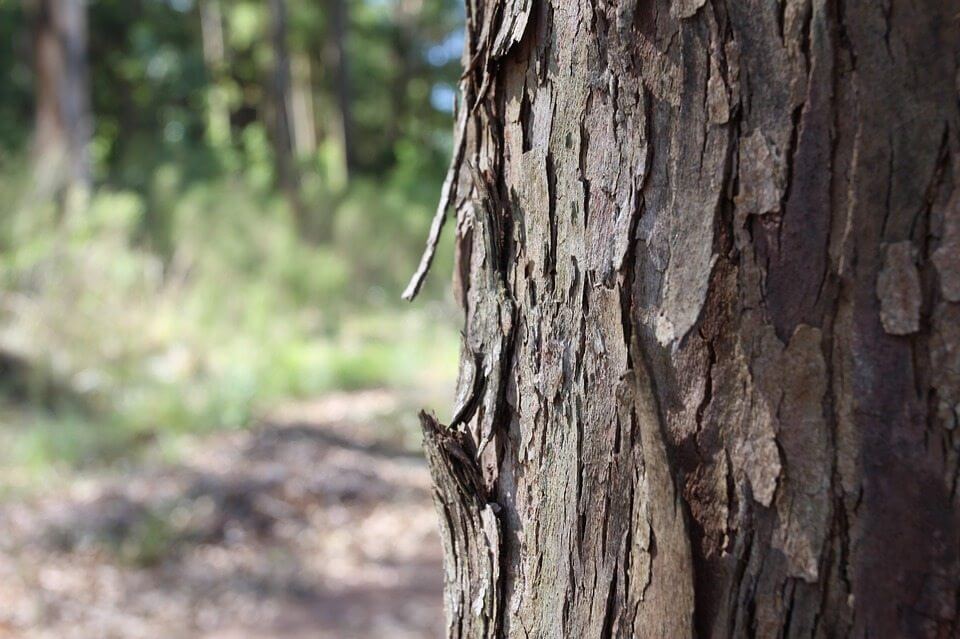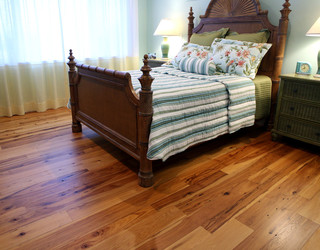Species Profile: Hickory
May 30, 2015

Hickory’s density and toughness have made it an icon of domestic wood, used by the westward-bound pioneers in their wagon wheels, for the frames of early airplanes, in baseball bats, golf clubs, skis, tools – anything that needed a strong, reliable material that could take some serious abuse.
Hickory trees produce some of the hardest and toughest wood in North America. Though more than a dozen species grow throughout the Northeastern and Southern United States, as well as areas of Canada and Mexico, only 8 are typically used in flooring. The most popular of these is called Shagbark Hickory, or Carya ovata. It is considered one of several “True Hickory” species (along with Pignut Shellbark, and Mockernut), which are somewhat denser and harder than their “Pecan Hickory” cousins (these include common Pecan as well as Water, Bitternut, and Nutmeg Hickory). However, most of the Carya species are almost indistinguishable from one another in appearance once milled.
Hickory is one of very few species in North America to have survived the disastrous Glacial Epoch. This puts it on the continent at least 50 million years ago, making it likely the very first North American hardwood species. This is a good thing, since a Hickory tree can take as long as two centuries to fully mature.
Color
One of Hickory’s most distinguishing features is its widely variant coloring. The sapwood of Hickory tends to be very pale, almost white, while the heartwood is relatively dark, usually reddish brown. Though it is possible to get Hickory in one or the other tone, it is most often cut to display both tones in a single board. For this reason, wider planks are often preferred for Hickory, to display the beautiful colors and to avoid creating too busy an effect.
Grade
The grade and cut of your Hickory boards will make a big difference – bigger than with most woods – in its appearance. Hickory must be carefully milled, not only because its density makes it difficult to cut, but because each cut must be made to best display the wood’s character.
If you are interested in Hickory primarily for its hardness and want a more consistent color, you will want to look for Select Grade. #1 and 2 Common Grade Hickory will display more of the natural color variation, sometimes referred to as “calico”, as well as some knots and unique mineral streaking that give the wood its unique, rustic character.
Of all the woods out there, Hickory is one that shines the most in Character, or Country, Grade. This is because its coloring lends itself well to a rural, rustic look and the “flaws” in what is normally a lower grade wood, only serve to enhance this effect. For this reason Country Grade Hickory is often used in place of antique wood flooring, which can be quite expensive and less durable.

Durability
As we mentioned, Hickory, particularly True Hickory, is one of the densest and hardest domestic woods. With a Janka hardness rating of 1820 (Hard Maple comes in at 1450 and White Oak at 1360), it can withstand a great deal of wear and tear and is uncommonly resistant to typical dings and scratches. This makes it an outstanding option for commercial spaces and for homes with families or pets, even large dogs.
However, this toughness comes at a price. Hickory is not an ideal wood for the do-it-yourselfer. It can be very difficult to cut and has been known to damage and break tools during installation. Further, boards will tend to show sanding marks if this is not done just right. Consequently, if you wish to have your Hickory floors finished onsite, you should definitely plan for the added expense of professional installation.
Stain
Experience seems to vary when it comes to staining Hickory. Because its natural color variations are so appealing, people often choose to finish it without a stain. Some, however, will use a light stain to help highlight this feature while others will try a darker stain to tone it down.
Hickory’s density can make staining tricky, though, and those desirable color variations can make the results unpredictable and uneven for all but the most experienced. It takes a seasoned professional to apply stain in a way that will cause it to penetrate more than the very surface of the wood and to get an even stain across much older heartwood and less dense sapwood.
There is, of course, a simple solution to both staining a finishing difficulties – prefinished Hickory. Though it may cost a little more initially, it will save time, trouble, and ultimately money to buy Hickory planks that have been cut and finished in the factory.
Stability
One of the few areas where Hickory can fall short is stability. It has a higher tendency toward movement than many of its domestic counterparts and must be kiln-dried after milling. For this reason, it is crucial to purchase Hickory only from reputable dealers and manufacturers who can guarantee that the boards have been dried properly. Once delivered, the acclimation period recommended for any hardwood flooring is especially important in order to avoid warping. If these precautions are taken, however, Hickory will prove plenty stable once installed.
Hickory at a Glance
- Very hard (Janka 1820)
- Great for pets and families
- Distinctive color variation
- Great for rustic or antique looks
- Best purchased pre-finished, not DIY-friendly







